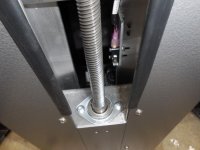jkilroy
Diamond
- Joined
- Jul 23, 2004
- Location
- Vicksburg, MS
I have a linear motion application that is turning out to be kinda tricky. I need a motion range of around 12" with a variable speed range of .25 ips down to .05 ips. This is a vertical lift application with a total load of close to 100lbs. Basically I need to cover a 5.5" distance in times between 24 seconds and 96 seconds.
I have tried to do this with off the self linear actuators using a variable voltage power supply and at the moment the system is either too fast to cover the entire range, or too slow. This needs to be one motion, no pauses or stops.
I have tried to do this with off the self linear actuators using a variable voltage power supply and at the moment the system is either too fast to cover the entire range, or too slow. This needs to be one motion, no pauses or stops.





